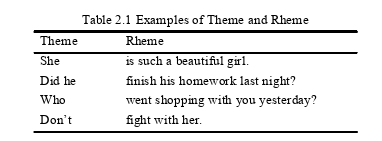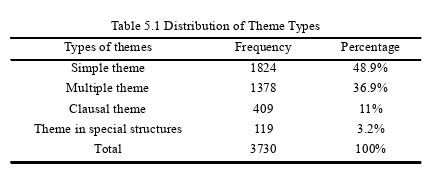本文是一篇英语论文,通过分析这些说明文中的主位结构和主位推进模式,得出结论。根据第五章中的结果和讨论,主要发现将总结如下。首先,从主位结构和主位推进模式两个方面分析了270篇说明文的主位特征。主位结构主要从主位类型和主位标记两个方面进行介绍。主位类型分析结果表明,简单主位所占比例最大,其次是复合主位、小句主位和特殊结构主位(48.9%、36.9%、11%和3.2%)。
Chapter One Introduction
1.1 Research Background
English is the official language in many countries, which even use English in daily life.English has even become the dominant business language. A large number of globalcompanies are using English as their primary language. There is no denying that English playsan important role in many aspects of life. As a developing country, China still uses English asa foreign language, and it is mainly taught at school. Every language has its own systemwhich is different from other languages, and so is English. As a foreign language, English hasa different system from Chinese. Therefore, it is no doubt that sometimes English is difficultfor Chinese students to learn.
Listening, speaking, reading and writing are four basic skills to master English. Since2002, the Ministry of Education has been promoting the reform of college English teachingbecause of the relatively weak listening and speaking abilities of college students. The maingoal of the teaching reform is to cultivate students’ comprehensive English ability, especiallylistening and speaking abilities. Under the guidance of the curriculum requirements and thepromotion of education reform by the Ministry of Education, most colleges and universities inChina are teaching students in accordance with the new college English teaching goals. Tosome extent, it is reasonable, but the goal is periodic and temporary. With the improvement ofcollege students’ English listening and speaking abilities, the goal of college English teachingin China should be shifted again in time. On the basis of solving the problem of listening andspeaking, the goal of college English teaching should focus on the cultivation of Englishreading and writing abilities, which are needed by the country to compete with other countriesin the field of science and technology (Cai, 2011).
1.2 Research Purposes
Based on theme-rheme theory, this thesis attempts to analyze the English expositorywritings extracted from the corpus of Spoken and Written English Corpus of ChineseLearners 2.0, which includes 270 expository writings written by junior English majors. Andthere are two purposes in this research.
First of all, it sets out to analyze the general features of thematic structure and thematicprogression pattern demonstrated in all the 270 expository writings of Chinese Englishmajors.
The second purpose is to find out the differences of thematic features in expositorywritings of Chinese English majors among high proficiency group, medium proficiency groupand low proficiency group.
There are few investigations about the thematic features in expository writings byChinese English majors based on corpus, so the thesis is comparatively new.

Chapter Two Literature Review
2.1 Theme and Rheme
2.1.1 Origin and Development of Theme and Rheme
The study of theme in foreign countries starts earlier. A French scholar Henri Weil is thepioneer in the studies of theme. In 1939, the Czech linguist Vilem Mathesius defined themeand rheme for the first time. And in 1967, the systemic functional school represented byMichael Halliday introduced them into his own theoretical framework. Since then, more andmore foreign scholars have begun to give their attention to the theme and rheme theory.
Foreign scholars have studied the research on theme first. The concept of theme inmodern linguistics generally dates back to Henri Weil, a scholar in the 19th century. Weil(1978) proposes that the syntactic movement is not equal to the movement of ideas. He holdsthat syntactic movement is represented by suffixes (the case form of nouns), while themovement of ideas is represented by word order. From the perspective of the movement ofideas, a sentence has a point of departure and a discourse goal. The former is known to bothsides of the conversation, while the latter is new information to the hearer. He notices thatsometimes a sentence can be reversed, starting with the goal. This kind of sentence is usuallyemotional. Weil calls Syntactic Movement “objective movement” and the movement of ideas“subjective movement”. When the order of the movement of ideas is reversed, he calls it“affective word order” (Jiang, 2008).
2.2 Related Studies of Theme-rheme Theory
2.2.1 Studies of Theme-rheme Theory in Different Genres
2.2.1.1 Studies Abroad
Some of these empirical studies abroad are mainly discussing the characteristics ofthematic structure in different genres and the similarities and differences between differentgenres of discourse.
Francis (1990) makes a contrastive study on the thematic structure of three differentgenres, namely, news reports, editorials and complaining letters. The results show that in thethematic structure, material and verbal processes are mainly used in news reports; relationalprocesses accounts for a large proportion in editorials and complaining letters, andinterpersonal themes are used more frequently in editorials and complaining letters than thosein news reports.
In order to explore the potential structure of markedness in scientific discourse, Gosden(1992) analyzes and describes the marked themes in the corpus of research articles. He findsthat the marked theme plays an important role in the discourse structure of scientific papers.Whittaker (1995) analyzes the argumentative and expository paragraphs in her researchpapers and finds that the proportion of marked themes and textual themes in argumentativeparagraphs is higher.
Martinez (2003) makes a comparative study on thematic structure in the methodsections(descriptive texts) and the discussion sections(argumentative text) of biologicalacademic papers. This research analyzes the corpus of 30 academic journal articles. Theresults show that different genres of the two sections may attribute to the differences: themethod section belongs to descriptive texts and the discussion sections belongs toargumentative texts.
Chapter Three Theoretical Framework................................21
3.1 Theme and Rheme Theory....................................21
3.1.1 Thematic Structure..............................................21
3.1.2 Thematic Progression Pattern................................. 27
Chapter Four Methodology........................37
4.1 Research Questions....................................37
4.2 Corpus...................................... 37
Chapter Five Results and Discussion........................................ 47
5.1 The General Thematic Features.................................... 47
5.1.1 The General Features of Thematic Structure........................................... 47
5.1.2 Discussion.............................. 48
Chapter Five Results and Discussion
5.1 The General Thematic Features
5.1.1 The General Features of Thematic Structure
The general features of thematic structure will be introduced from two aspects: the themetypes and markedness of theme. The table below presents the results after 270 expositorywritings are fully analyzed according to the theoretical framework put forward in ChapterThree.
5.1.1.1 The General Features of Theme Types

As we can see from the table, there are a total of 3730 themes used by 270 expositorywritings. Table 5.1 shows that the 270 expository writings have used 1824 simple themes,indicating that the simple theme accounts for a large proportion of all the theme types.Multiple theme takes up the second position, accounting for 1378 of the total theme types. Itis followed by the clausal theme, which is 409 of the total theme types. Theme in specialstructures takes up the smallest proportion among the four types, with only 3.2% of the totaltheme types.
Chapter Six Conclusion
6.1 Major Findings
By analyzing the thematic structure and thematic progression patterns in these expositorywritings, conclusions are given in this part. According to the results and discussion in theChapter Five, the major findings will be summarized as follows.
Firstly, the general thematic features of all the 270 expository writings are discussedfrom the aspects of thematic structure and thematic progression pattern. The thematicstructure is mainly introduced from two aspects: the theme types and markedness of theme.The results of theme types show that the simple theme has the largest proportion, followed bymultiple theme, clausal theme and theme in special structures (48.9%, 36.9%, 11% and 3.2%).Students tend to use simple themes, which make their writings easier to understand. Perhapsit’s because simple themes are much easier for students to grasp. As for the components ofmultiple theme, experiential theme has the largest proportion, followed by textual theme andinterpersonal theme (48.8%, 43.7% and 7.5%). Through textual analysis, it is found that whenexperiential themes are used, a large majority of them center around the writing topic of KFCand MacDonald’s or other concepts that are closely related to KFC and MacDonald’s. When itcomes to the markedness of theme, it is obvious that unmarked themes are the most frequentlyused by the students (77.3%). The reason why Chinese English learners tend to use unmarkedthemes may be influenced by their mother tongue.
Six patterns of thematic progression are analyzed in this thesis. The results of thematicprogression patterns show that there are some differences among the use of different kinds ofthematic progression patterns. It is found that constant theme progression pattern is the mostfrequently used. It is followed by simple linear progression, constant rheme progression, splitrheme progression, derived-theme progression and zigzag progression. The first three patternsoccur more frequently in students’ expository writings, which helps the sentences or ideas toflow in a direct manner. The use of these three patterns requires the basic ability of organizingthe text, while the other three patterns guarantee more complex structures of the paragraphs,which can make the writings more coherent.
reference(omitted)
